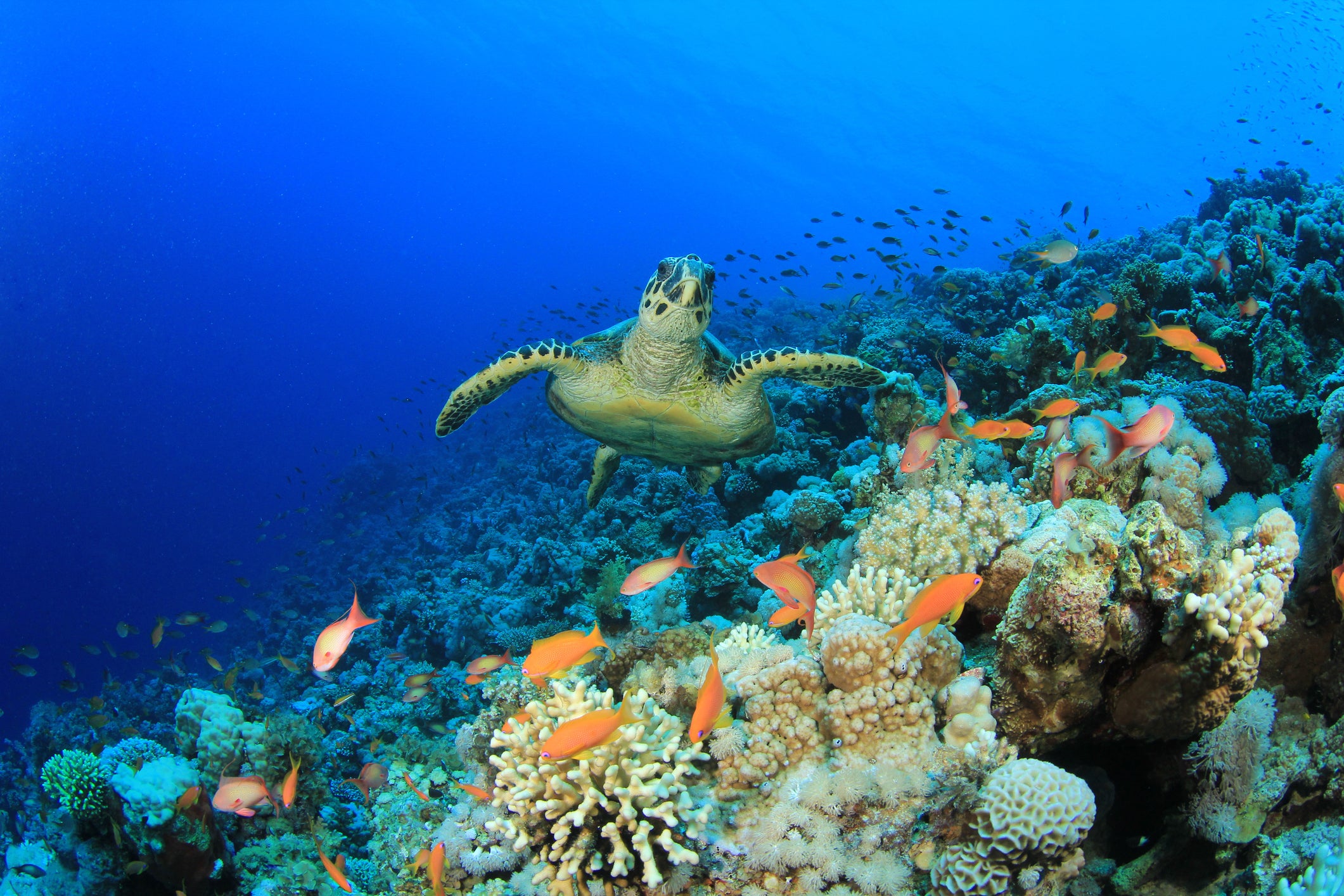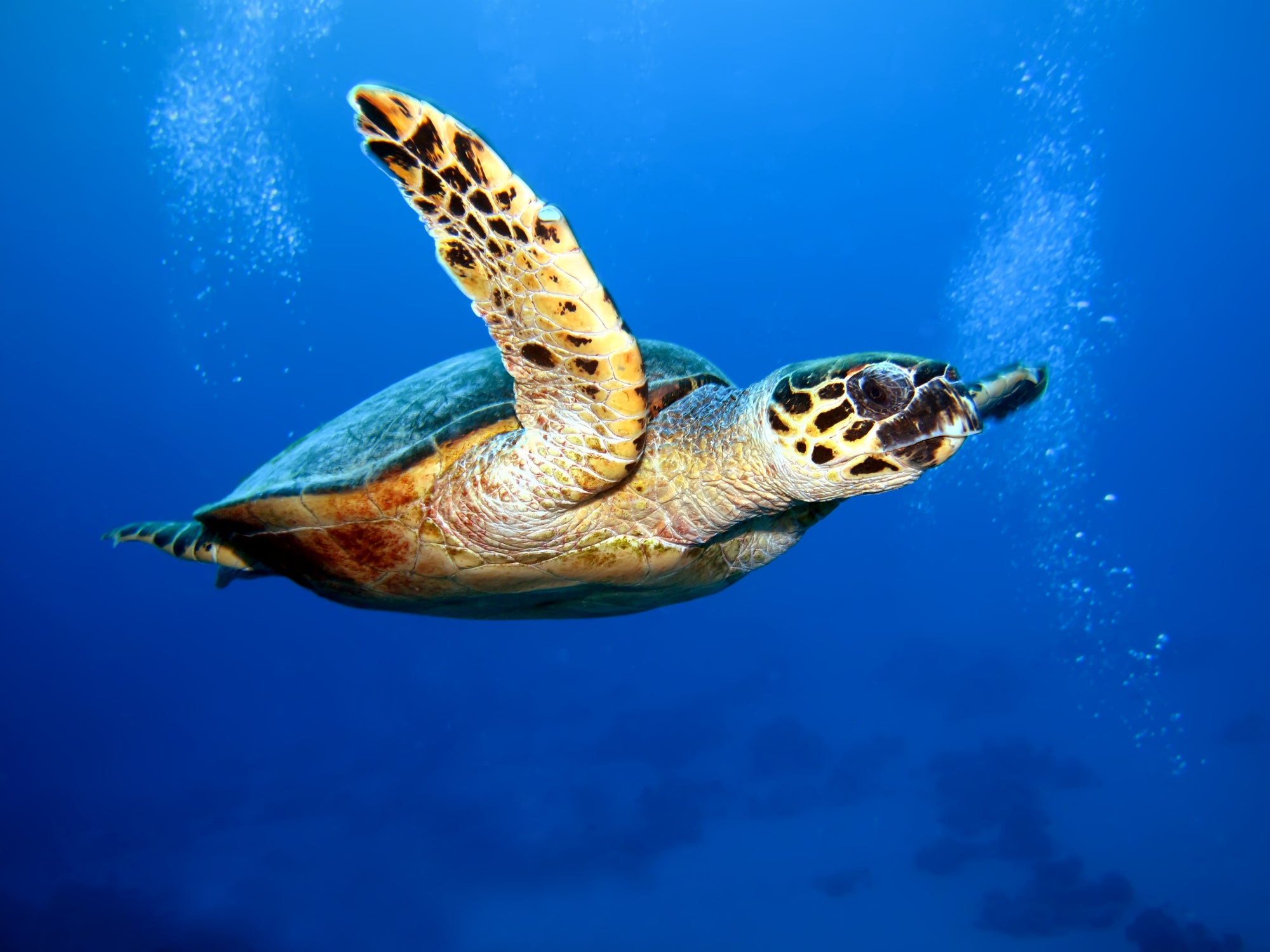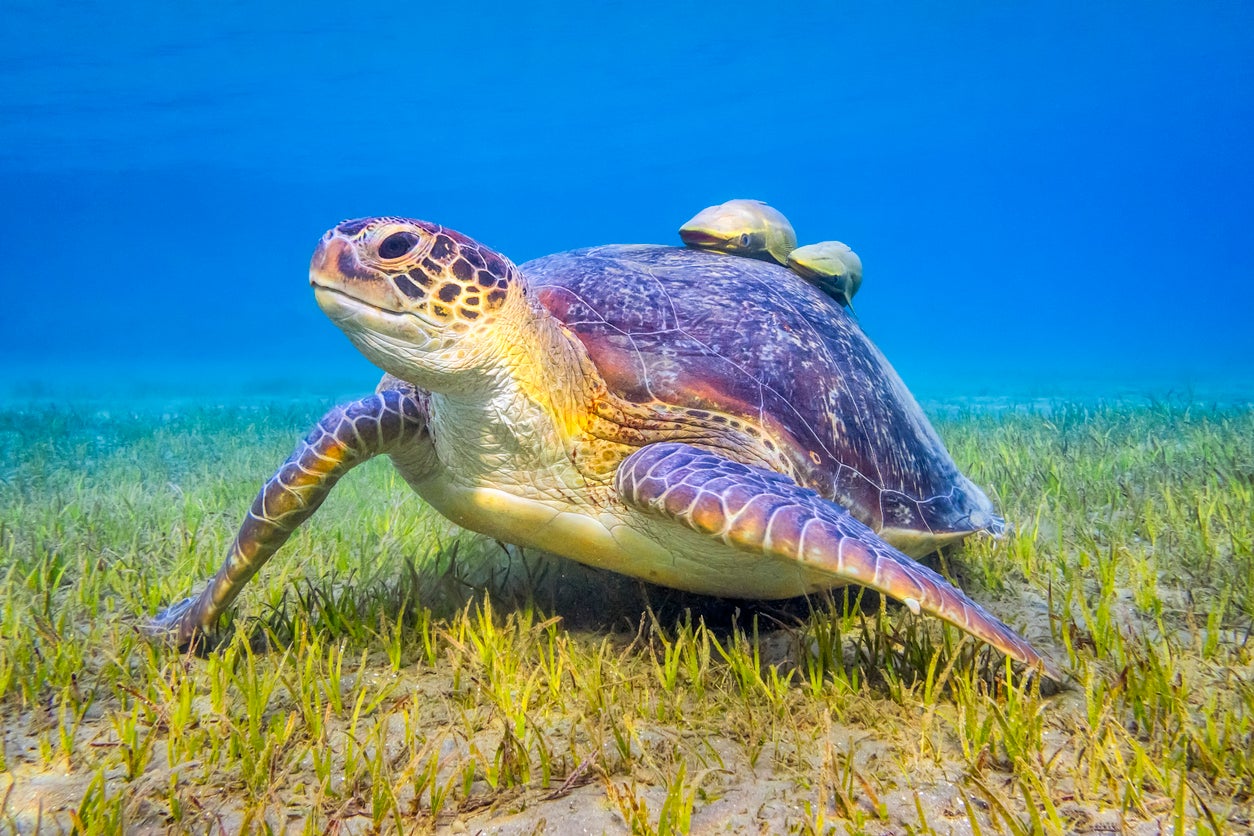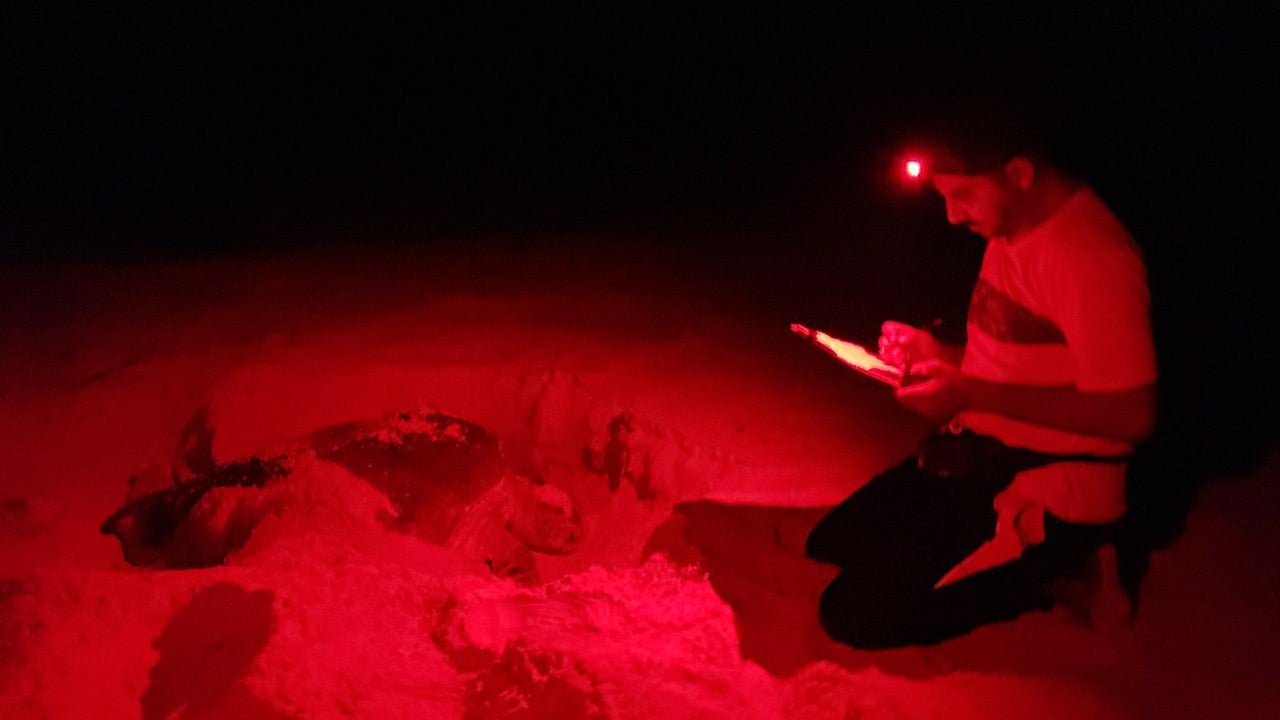The fight to save sea turtles in Ras Baridi: Against the odds
Turtles have been around for as long as the dinosaurs but their numbers are falling. In Ras Baridi, on Saudi Arabia’s west coast, the Ba’a Foundation is trying to find solutions

A sea turtle’s struggle for survival starts from the moment it emerges from its shell.
Having spent a gestation period of six to seven weeks under the cover of half a metre of sand, the hatchling, measuring a mere 5cm in length, must crawl out from under its heavy protective shelter and all the way down the beach to the sea, propelled by tiny flippers that could appear poorly adapted for the job.
On this already arduous journey, it must also evade – if it can – the predatory attention of crabs, seabirds, and even rats, feral dogs or foxes. Meanwhile, artificial light can disorient the hatchlings, as they use moonlight to navigate towards the sea, and reduce their chances of survival.
Assuming it survives these initial hazards, more dangers await once the hatchling enters the apparent safety of the ocean. Sharks, other fish, and octopuses will all welcome the chance to snap up a turtle snack should it come their way.
The odds are certainly stacked against these marine reptiles. In fact, there’s a popular notion that only one in 1,000 hatchlings make it to adulthood to breed. But the truth is, there is much we don’t know about sea turtles, including their survival rate, because, apart from when the females come ashore to lay their eggs, they spend their entire lives at sea.
We do know that their numbers have been dropping all over the world, though.
There are seven species of sea turtles in the world: loggerhead, leatherback, olive ridley, green, Kemp's ridley, hawksbill, and flatback. Of these, the first three are classed as vulnerable by the world’s wildlife conservation body, the International Union for Conservation of Nature (IUCN); greens are endangered, Kemp's ridley and hawksbill are critically endangered, and there isn’t enough data to assess the status of flatbacks.
A turtle haven

Ras Baridi, an area just north of the city of Yanbu on the west coast of Saudi Arabia, is unusual according to Dr Hector Barrios-Garrido. The sea turtle specialist is part of a team of scientists from the Beacon Development Company (BDC), a wholly-owned subsidiary of the King Abdullah University of Science and Technology (KAUST) that’s heavily involved in the conservation efforts.
Extensive research conducted by KAUST’s Professor Carlos M. Duarte, one of the world’s leading authorities on marine science, has shown that this stretch of coastline is the most important turtle nesting site – or rookery – in the whole of the Red Sea. In some years, 360 green turtles, plus a handful of hawksbills, come ashore to lay their eggs on Ras Baridi’s sandy beach. Only Zabargad Island, on the other side of the Red Sea, off the coast of Egypt, has comparable numbers.
There’s also the fact that Ras Baridi is on the mainland – if you look around the world, the majority of sea turtle nesting sites are found on islands. One reason might be the abundance of seagrass in the area. Professor Duarte’s research suggests that Ras Biridi has the largest seagrass meadow in the Red Sea, perfect for breeding sea turtles that need a stable food source while laying their eggs.
To protect this special area and help reverse the odds in the turtle’s favour, the Ba’a Foundation – a Saudi Arabian non-profit organisation that focuses on preserving endangered species and natural habitats, as well as the country's cultural and historical sites – has created the Ras Baridi Marine Turtle Conservation Initiative using KAUST’s research, and tasked the BDC with its implementation.
The central aim is to increase the number of hatchlings that emerge from their nests and successfully make that journey down to the sea. It’s seen as one of the key actions that will help to grow the sea turtle population, echoing their own strategy for survival, derived from evolution.
The numbers game
All sea turtles take decades to reach maturity – hawksbills, for example, are not ready to breed until they are between 20 and 40 years of age. But once they are ready to breed, it becomes a numbers game.
Female sea turtles breed on average every three years and as they get older, this frequency improves to every other year. During each reproductive year, they can nest up to five times, with a single female laying up to 100 eggs in each nest. The goal is to produce huge numbers of offspring in the expectation that at least some – despite the heavy death toll when they are very young – will live long enough to produce the next generation.
And until the past century or so, nature’s strategy has worked extremely well. This group of reptiles are some of planet Earth’s ultimate survivors, having been around more or less in the same form they now take for at least 180 million years.
As Dr Barrios-Garrido puts it: “They survived the dinosaurs’ time, and now they are endangered. Are we humans worse than a meteorite?”
The immediate threats are obvious. All over the world, turtles have been exploited for their eggs, oil content, meat and intricate shells. They are also accidentally caught and drowned in commercial fishing nets, while chemical pollution and ingestion of plastic (plastic bags resemble jellyfish, one of their favourite foods) are becoming increasingly problematic. Loss of nesting beaches to developments, especially in tourist hotspots, is another massive issue. And of course, the aforementioned light pollution that’s endangering the species as soon as they hatch.
In the longer term, scientists are also concerned about what impact rising temperatures and sea levels could have. Temperature determines the sex ratio of a turtle clutch – the warmer it is, the more females there are – so global warming could lead to a gender imbalance unless the turtles migrate to a different latitude.
Rising sea levels, meanwhile, can result in lost nesting habitats and more nests failing if they are flooded by seawater before the eggs hatch. This has already led to large nesting failures in Ras Baridi over the past two years, according to Professor Duarte.

It seems that the sea turtle’s penchant for always returning to the same nesting and feeding grounds and their dependence on low-lying nesting beaches – evolutionary traits shared by all species – is now contributing towards their long term decline.
The challenge at Ras Baridi
Despite the high volume of turtle traffic, Ras Baridi faces its own set of challenges, brought about by its proximity to humans.
One issue is that people drive along the beach when they visit the area. This is potentially disastrous for the turtles, because it compacts the sand where the nests are laid.
“The female digs up the sand when she lays her eggs, and this makes it softer so the hatchlings can breathe and dig their way out,” says Dr Barrios-Garrido. “When you compact the sand, even if you only walk on it, this makes it harder. And if it’s a car, it will be much worse – that can even crush the eggs.”
Coastal developments, including new roads and walls at the nearby Yanbu Cement Factory, have also encroached on the nesting areas in recent years, according to the project’s director, Dr Ricardo Oliveira Ramalho. “We find female turtles are trying to move further up the beach, perhaps looking for an ideal place to dig their nest, and are forced to cross roads or end up walking along the cement company’s perimeter wall before returning to the beach,” he says.
And then there’s the problem of cement dust from the factory. A 1999 study found that up to an estimated 120 tonnes of partially processed cement dust was blown onto nearby beaches each day, solidifying and forming thick crusts as it came into contact with the wet sand. Only 40 per cent of hatchlings successfully emerged from nests covered by this crust. Fortunately, when that crust was removed, the success rate went up to 80 per cent.
Since that study was published, the Yanbu Cement Company has continuously invested in dust suppression systems at its factory to reduce the amount of cement dust blown onto Ras Baridi’s beach. It has also become a key stakeholder in the area’s conservation efforts thanks to the Ba’a Foundation.
In fact, since the inception of the Ras Baridi Marine Turtle Conservation Initiative, the Ba’a Foundation has been instrumental in connecting all the private and public sector stakeholders so they can collaborate to actively protect Ras Baridi’s sea turtles. Together, the partners are raising awareness around how human activities threaten the turtle population at Ras Baridi. There are also plans to hire personnel to supervise and enforce current protective measures, while monitoring the turtles’ breeding and nesting activities.
The Foundation has also brought on board the Ministry of Defence, which has put up new fences to make sure people physically can’t get onto the beach in their cars, and the Ministry of Environment, Water and Agriculture to oversee the project.
“Each team has its own speciality and are working together to bring our conservation efforts up to world-class standards,” says Bader Alrabiah, Executive Director of the Ba’a Foundation.
The search for solutions
Aside from addressing the area’s more immediate threats, the conservation efforts at Ras Baridi also cover initiatives spanning across research, education and action.
For example, conservationists can remove the eggs from nests that are threatened for any reason and place them in an in-situ hatchery. There, incubation and hatching rates can be closely monitored. And once hatched, the baby turtles can be released back onto the beach and guided into the sea to give them the best chances of survival.

Research is a key component of the conservation project as data collected may help BDC and KAUST scientists better understand the species’ ecology and how they can further help their survival.
The project will also investigate whether beach erosion – another threat that could reduce the available nesting space – is linked to rising sea levels or whether it’s a more localised problem. In addition, an assessment will soon be conducted to identify what could be done to improve the current beach quality for nesting, says Dr Ramalho.
A final element will be an education and environmental awareness programme, especially for local schoolchildren. It’s hoped they could be brought to the site and even watch the turtles emerge from the nests – one of the most magical wildlife events in the natural world. Tours could be organised for the general public as well in future. It’s a possible way of making them aware of, and care for, turtle conservation.
Save the turtles, save a whole ecosystem
Ensuring the long-term future of the Ras Baridi rookery is important, and not just for the turtles, says Dr Barrios-Garrido. Their presence transfers benefits from the seabed (where they feed) to the beaches because they help to feed other creatures within the ecosystem through their eggs and the hatchlings. And it’s a long breeding season, lasting six months from April through to November. In effect, they act as a keystone species for an entire ecosystem, stimulating the productivity of the habitat as a whole.
“They work very well as a conservation umbrella species, too,” adds Dr Ramalho. “We hope to show that the small actions this programme is planning to implement can make a big difference. If instead of 50 turtles swimming from one nest we have 100, that’s a 100 per cent increase.”
Dr Barrios-Garrido agrees. “If we want to save the population, then we need to increase the number of hatchlings that survive,” he says. “We need to keep doing the measures to reduce bycatch in fisheries, to minimise pollution in the sea, but the biggest thing is to increase baby turtle survival rates. After they enter the water, there are sharks, there are octopuses, there’s not much you can do.”
“Now everything depends on humans; good actions and bad actions,” he adds. “In the future, I want to see my daughter and say I did my best. I want to be alright with that.”
Ultimately, turtles have been around for millions of years. And as Dr Barrios-Garrido says, do we really want to be party to their demise?
This article was first published in October 2021.
The Saudi Green Initiative is Saudi Arabia’s whole-of-government approach to combat climate change.
